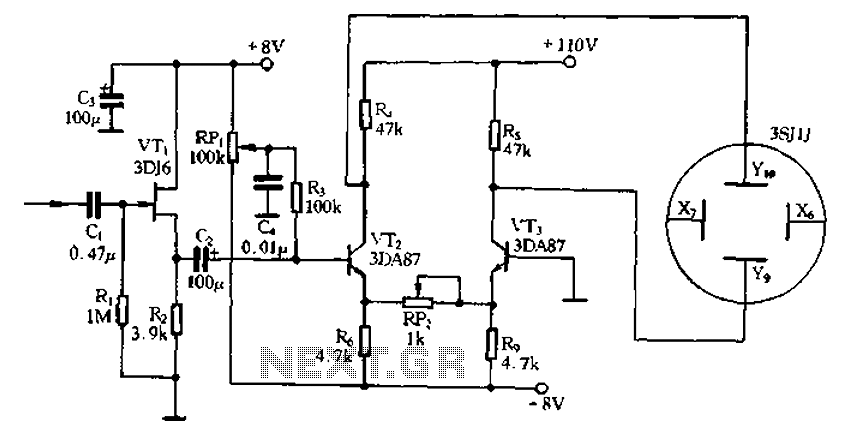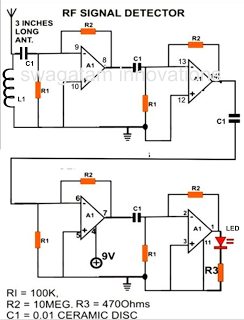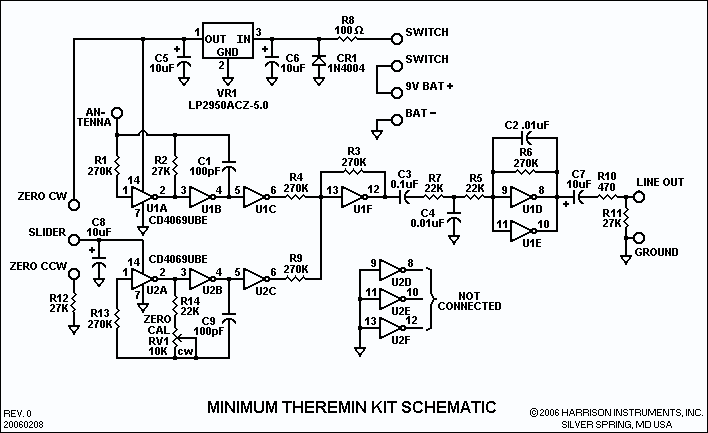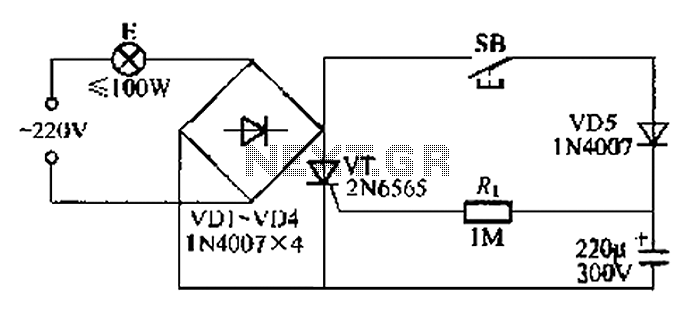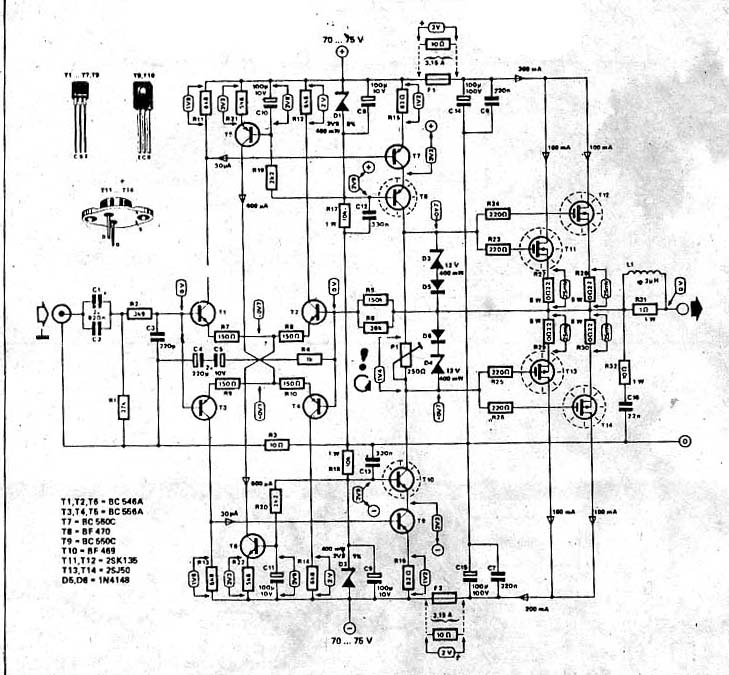
Remote-Control Analyzer Circuit
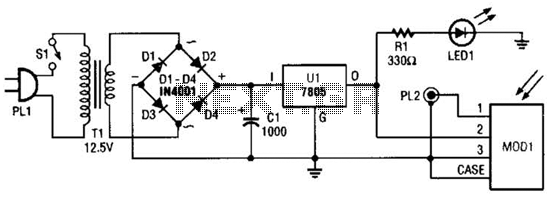
A schematic diagram for the remote analyzer is presented. The circuit is powered by a simple 5-V supply, which includes components such as PL1, SI, Tl, a bridge rectifier formed by diodes D1 through D4, capacitor CI, and a standard 5-V regulator, Ul. The switch SI serves as the on/off control and is optional. The power supply transformer used in the prototype is a 12.6-Vac unit; however, any transformer capable of supplying at least 5.6-Vac can be utilized. The 12.6-V transformer was selected due to its availability. The output from Tl is full-wave rectified by diodes D1 through D4 and filtered by CI. The fluctuating DC output from the capacitor is regulated down to 5 V by Ul, a 7805 integrated regulator. LED1 functions as a power indicator, signaling that the circuit is operational. The 5-Vdc output powers a GPIU52X infrared detector module (MODI), which demodulates the 40-kHz carrier signal used by most infrared remote controls. After demodulation, the resulting logic pulses are transmitted to an oscilloscope via PL2, a BNC connector.
The remote analyzer circuit provides a straightforward yet effective means of analyzing infrared signals. The power supply section begins with a transformer that converts the AC mains voltage to a lower AC voltage, suitable for the needs of the circuit. The 12.6-V transformer is connected to a bridge rectifier made up of four diodes (D1 to D4), which converts the AC voltage to pulsating DC. The capacitor (CI) smooths out the ripples in the rectified output, providing a more stable DC voltage to the subsequent components.
The 7805 voltage regulator (Ul) is a crucial component that ensures the output voltage remains at a constant 5 V, regardless of variations in input voltage or load conditions. This regulated voltage is essential for the proper functioning of the infrared detector module (MODI).
The GPIU52X infrared detector module is designed to demodulate signals at a frequency of 40 kHz, which is a common carrier frequency for infrared remote controls. This functionality allows the circuit to effectively capture and analyze infrared signals transmitted from remote control devices. The demodulated output, which consists of logic pulses representing the transmitted signal, is then routed to an oscilloscope through the BNC connector (PL2). This allows for visual analysis of the signal waveform, facilitating troubleshooting and verification of remote control operations.
LED1 serves as a visual indicator of the circuit's operational status, providing immediate feedback to the user when the circuit is powered on. The inclusion of the optional switch (SI) allows for convenient control of the circuit's power without the need to disconnect the power supply. Overall, this schematic diagram illustrates a well-designed circuit for analyzing infrared remote control signals, combining essential components for power regulation, signal demodulation, and user feedback. A schematic diagram for the remote analyzer is shown. The circuit is powered from a simple 5-V supply, consisting of PL1, SI, Tl, a bridge rectifier (comprised of D1 through D4), capacitor CI, and a common 5-V regulator, Ul. Switch SI is the on/off control and is optional. The power-supply transformer used in the prototype is a 12.6-Vac unit, but any transformer that can supply at least 5.6-Vac will do.
The 12.6-V unit was used solely because of its availability. The output of Tl is full-wave rectified by diodes D1 through D4 and filtered by CI. The bumpy dc output from the capacitor is regulated down to 5 V by Ul, a 7805 integrated regulator. LED1 acts as a power indicator to let you know that the circuit is active. The 5-Vdc powers a GPIU52X infrared-detector module* (MODI), which demodulates the 40-kHz carrier used by most infrared remotes. After demodulation, the resulting logic pulses are sent to an oscilloscope via PL2, a BNC connector.
The remote analyzer circuit provides a straightforward yet effective means of analyzing infrared signals. The power supply section begins with a transformer that converts the AC mains voltage to a lower AC voltage, suitable for the needs of the circuit. The 12.6-V transformer is connected to a bridge rectifier made up of four diodes (D1 to D4), which converts the AC voltage to pulsating DC. The capacitor (CI) smooths out the ripples in the rectified output, providing a more stable DC voltage to the subsequent components.
The 7805 voltage regulator (Ul) is a crucial component that ensures the output voltage remains at a constant 5 V, regardless of variations in input voltage or load conditions. This regulated voltage is essential for the proper functioning of the infrared detector module (MODI).
The GPIU52X infrared detector module is designed to demodulate signals at a frequency of 40 kHz, which is a common carrier frequency for infrared remote controls. This functionality allows the circuit to effectively capture and analyze infrared signals transmitted from remote control devices. The demodulated output, which consists of logic pulses representing the transmitted signal, is then routed to an oscilloscope through the BNC connector (PL2). This allows for visual analysis of the signal waveform, facilitating troubleshooting and verification of remote control operations.
LED1 serves as a visual indicator of the circuit's operational status, providing immediate feedback to the user when the circuit is powered on. The inclusion of the optional switch (SI) allows for convenient control of the circuit's power without the need to disconnect the power supply. Overall, this schematic diagram illustrates a well-designed circuit for analyzing infrared remote control signals, combining essential components for power regulation, signal demodulation, and user feedback. A schematic diagram for the remote analyzer is shown. The circuit is powered from a simple 5-V supply, consisting of PL1, SI, Tl, a bridge rectifier (comprised of D1 through D4), capacitor CI, and a common 5-V regulator, Ul. Switch SI is the on/off control and is optional. The power-supply transformer used in the prototype is a 12.6-Vac unit, but any transformer that can supply at least 5.6-Vac will do.
The 12.6-V unit was used solely because of its availability. The output of Tl is full-wave rectified by diodes D1 through D4 and filtered by CI. The bumpy dc output from the capacitor is regulated down to 5 V by Ul, a 7805 integrated regulator. LED1 acts as a power indicator to let you know that the circuit is active. The 5-Vdc powers a GPIU52X infrared-detector module* (MODI), which demodulates the 40-kHz carrier used by most infrared remotes. After demodulation, the resulting logic pulses are sent to an oscilloscope via PL2, a BNC connector.
